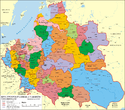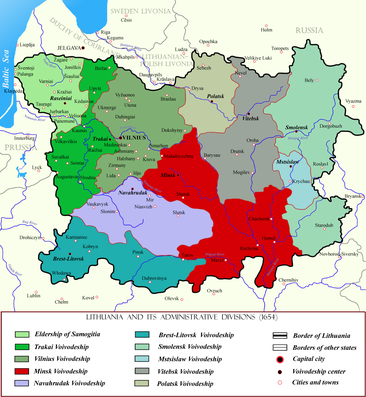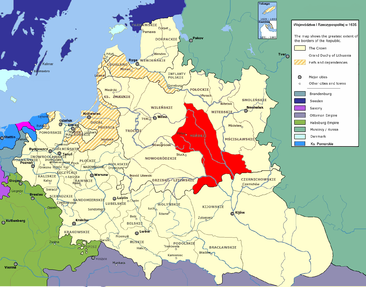- Minsk Voivodeship
-
Minsk Voivodeship (Belarusian: Менскае ваяводзтва, Menskaje vajavodztva, Polish: Województwo Mińskie, Latin: Palatinatus Minscensis) was a unit of administrative division and local government in Grand Duchy of Lithuania since 1413 and later in Polish-Lithuanian Commonwealth till the partitions of the Commonwealth in 1795. Centred around the city of Minsk and subordinate to the Grand Duchy of Lithuania, the region continued the traditions - and shared the borders - of several previously existing units of administrative division, notably a separate Duchy of Minsk, annexed by Lithuania in the 12th century.
Contents
Geography
The voivodeship was stretched along the Berezina and Dneper rivers, with the earlier river having both its source and its estuary within the limits of the voivodeship, as well as most of its basin. To the north east it bordered Polotsk, Vitebsk and Mscislaw voivodeships. To the east it bordered with the lands of Chernigov (on both sides of the Dneper and Sozh rivers), while to the south-east it was delimited by the river Snov. Further southwards the voivodeship was bordering the land of Kiev. Across the basin of the Pripyat river the land of Minsk was bordering the Brześć Voivodeship (across Ubort river) and Nowogródek Voivodeship (across Ptsich river). Further northwards it was bordering the capital of the Grand Duchy, the Vilnius Voivodeship.
History
Minsk had been a capital of a semi-independent duchy at least since 1067. Raided on a yearly basis by Lithuanian tribes, by 12th century it was made a fief and in 14th century it was directly incorporated into the Grand Duchy. It was king Władysław II of Poland to create the voivodeship in 1413.[citation needed] However, it was not until 1500 that its borders were delimited. Around that time the Minsk voivodeship had been divided onto three powiats, with capital cities in Minsk, Mozyr and Rechytsa. The latter was further divided onto the land of Rechytsa and land of Rahachow. In the meantime, in 1441 the city of Minsk was granted with a city charter, by the king Casimir IV Jagiellon. His son, Alexander Jagiellon extended the privilege in 1496 and granted the town with Magdeburg Laws. Since then, the entire region shared the fate of its capital city. In 1773 a post-Jesuit academy had been founded in Minsk by the Commission of National Education.
Politics
All voivodeships played an important role within the Polish political system, extended to Lithuania by the Polish-Lithuanian unions. Following the final Union of Lublin of 1569, the Minsk Voivodeship received two seats within the Senate. The seats were held ex officio by the voivod and the castellan of Minsk. Each of the three powiats organized its own Sejmik, which had a right to elect two members of Sejm each, and two deputies to the Lithuanian Tribunal.
The three cities were also entitled to house local courts. Since 1599, the Tribunal of Lithuania did also held sessions in Minsk (every three years, other cities it visited were Vilnius and Navahrudak). The court held there served the role of the highest juridical authority for all of Ruthenian voivodeships, that is Minsk, Nowogródek, Vitebsk, Mstislav and Kiev. Following the first partition of Poland in 1775, the tribunal abandoned Minsk and held its sessions in Hrodna.
Notable voivodes of Minsk include Balcer Strawiński (1631-1633), Aleksander Suszka (1633-1638) and Mikołaj Sapieha (since 1638).
Colours
Much like other Ruthenian lands, the Minsk voivodeship signed its documents with the Pogoń (Chase) coat of arms. The flag was Or, in field Gules a chase Carnation. The official uniform was a crimson kontusz and żupan, with a navy blue collar. The powiat of Rechytsa adopted a white żupan with white collar.
References
- (Polish) Zygmunt Gloger (1903-1991). Geografia historyczna ziem dawnej Polski (Historical geography of the lands of former Poland). Warsaw: Wiedza Powszechna. p. 387. ISBN 83-214-0883-4.
Historical voivodeships of the Grand Duchy of Lithuania 
Trakai (1413) · Vilnius (1413) · Polotsk (1504) · Nowogródek (1507) · Smolensk (1508) · Vitebsk (1511) · Brest Litovsk (1566) · Minsk (1566) · Mstsislaw (1566) · Eldership of Samogitia
Transferred to the Crown of the Polish Kingdom by the Union of Lublin (1569): Kiev (1471) · Podlaskie (1513) · Bracław (1566) · Volhynian (1566)
Administrative division of the Polish–Lithuanian Commonwealth Province of
Greater PolandBrześć Kujawski · Chełmno · Gniezno · Inowrocław · Kalisz · Łęczyca · Malbork · Masovian · Płock · Pomeranian · Poznań · Rawa · Sieradz · Prince-Bishopric of Warmia
Province of
Lesser PolandGrand Duchy of
LithuaniaBrest Litovsk · Minsk · Mstsislaw · Nowogródek · Polotsk · Smolensk · Trakai · Vilnius · Vitebsk · Duchy of SamogitiaPolish Livonia Fiefs Categories:- Former voivodeships of Poland (14th century–1795)
- Former voivodeships of Lithuania
- History of Minsk
Wikimedia Foundation. 2010.


